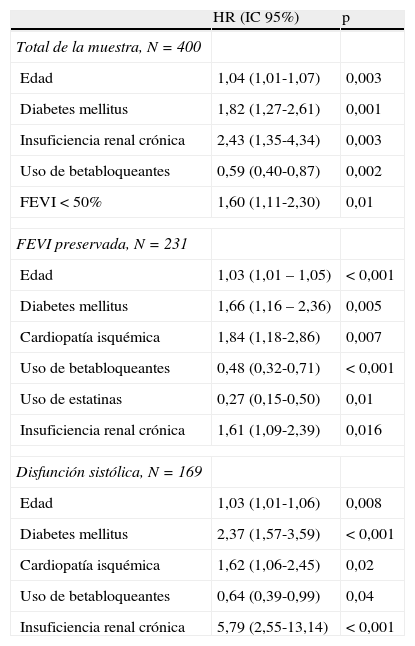Los objetivos de este estudio fueron evaluar los factores pronósticos y la mortalidad a largo plazo en pacientes con insuficiencia cardiaca (IC) tras su primer diagnóstico, analizar las diferencias en función de la fracción de eyección del ventrículo izquierdo (FEVI) preservada (ICFEP) frente a la disfunción sistólica (ICDS), y, por último, comparar los resultados con los descritos en las principales series de casos incidentes de IC publicadas.
Pacientes y métodoEstudio de cohortes retrospectivo en el que se incluyeron pacientes con primer ingreso por IC (criterios de Framingham) entre el 1-01-1997 y el 31-12-2001, clasificados en función de la FEVI mayor (ICFEP) o menor (ICDS) del 50%, seguidos durante un período máximo de 10 años.
ResultadosSe incluyeron 400 casos incidentes, 231 pacientes (57,7%) tuvieron ICFEP. A los 10 años la mortalidad fue mayor en la ICDS (64,5 frente a 55,4%, p=0,04). Las variables relacionadas con la mortalidad en ICFEP incluyeron edad, diabetes mellitus, cardiopatía isquémica e insuficiencia renal crónica. El tratamiento con estatinas y betabloqueantes se asoció a un mejor pronóstico. En ICDS los predictores de mortalidad fueron similares, aunque las estatinas no mejoraron la supervivencia. Respecto a otras series de casos incidentes, hubo diferencias en cuanto a las variables relacionadas con el pronóstico y la mortalidad de los pacientes.
ConclusionesTras el diagnóstico inicial de la IC, más de la mitad de los pacientes fallecen a los 10 años de seguimiento. La edad, la diabetes mellitus, la cardiopatía isquémica y la insuficiencia renal crónica se asocian a un peor pronóstico en estos pacientes, mientras que el uso de betabloqueantes se asocia a un mejor pronóstico.
To assess long-term mortality and prognostic factors after initial diagnosis of heart failure (HF), to analyze the differences in function of the left ventricular ejection fraction (preserved [HFPEF] vs. systolic dysfunction [HFSD]) and to compare the results with the main series of incident cases of HF published.
Patients and methodsRetrospective cohort study including patients first diagnosed of heart failure (Framingham criteria), between 1-01-1997 and 31-12-2001, classified according to a left ventricle ejection fraction (LVEF) above or equal to 50% (HFPEF) or below 50% (HFSD). Follow-up of patients was conducted during ten years.
ResultsOut of 400 incident cases of heart failure, 231 patients (57,7%) presented with HFPEF. At 10 years, mortality rates were higher in the HFSD group (64,5 vs. 55,4%, p=0,04). Following a multi-variant analysis, HFPEF mortality was related with age, diabetes mellitus, ischemic heart disease, and chronic renal failure. Treatment with statins and beta-blockers was associated with improved prognosis. Among patients with HFSD, mortality predictors were similar, although patients treated with statins did not show higher survival rates. For other series of incident cases, there were differences in variables related to prognosis and mortality of patients.
ConclusionsAfter an initial diagnosis of HF, more than half of patients die within 10 years of monitoring. Age, diabetes mellitus, ischemic heart disease and chronic renal failure are all associated with worse prognosis in these patients, whereas the use of beta-blockers and statins is associated with a better prognosis.














